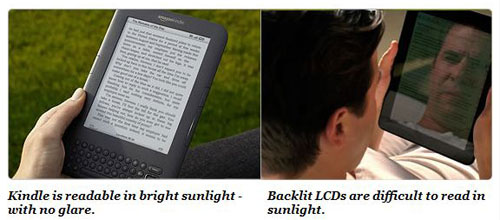I’ve been too busy lately to mention this, but a week or so ago, before the Nook Color was announced, I happened to notice that Amazon has added a new section to their Kindle product description pages comparing LCD displays with the E Ink Kindle screen.
The section is called E-Ink 101: Compare Kindle’s Screen to Traditional LCDs. They make sure to mention all the positives of E Ink displays over LCD: how the Kindle’s screen looks like real paper and doesn’t cause eyestrain like LCD tablets and laptops; how electronic ink has clearer, sharper text; that LCD displays reflect light and are difficult to read outdoors and in bright light; and how the Kindle’s battery will last for weeks instead of hours, complete with a hilarious graph that illustrates this point.
They even go as far as saying that LCD screens inhibit melatonin production, thus making it difficult to fall asleep at night, and that the Kindle is better to read before going to bed because it isn’t backlit. They quote an article from the Los Angeles Times about how reading on the iPad before you go to bed can affect sleeping habits.
“The take-home lesson is that insomnia and electronic gadgets emitting light should not [be] mixed before bedtime…Kindle is better for your sleep.”
The article doesn’t provide any hard data, however, basically relying on a couple of sleep experts’ opinions. Similar to the argument that reading on LCD displays causes more eyestrain than reading on an electrophoretic display like the Kindle. There seems to be a lot of opinion on these two subjects lately but nothing that proves or disproves it either way.
What if you turn the LCD screen to night-reading mode where the background is black? What about turning the brightness down? What about different types and colors of fonts and background colors? What about reading on an E Ink display in low light?
There are so many variables involved that it is impossible to make a blanket statement condemning or lauding either screen technology. Both have their pros and cons. Each person has different tastes, different likes and dislikes. Some people don’t like E Ink because it lacks color and requires the use of a light to read at night, and others get headaches and sore eyes when reading on LCD displays.
What it all comes down is personal preference and how each individual is or isn’t affected by certain types of stimuli. Each person has to make that decision for themselves with some simple hands-on testing. If you haven’t seen an E Ink screen in person yet, most electronics stores have them on display now. And if you haven’t tried reading on an LCD tablet or phone, you might be surprised by all the ways you can customize the reading experience by changing font type, background color, and being able to dim the brightness of the screen to minimize eye strain.

